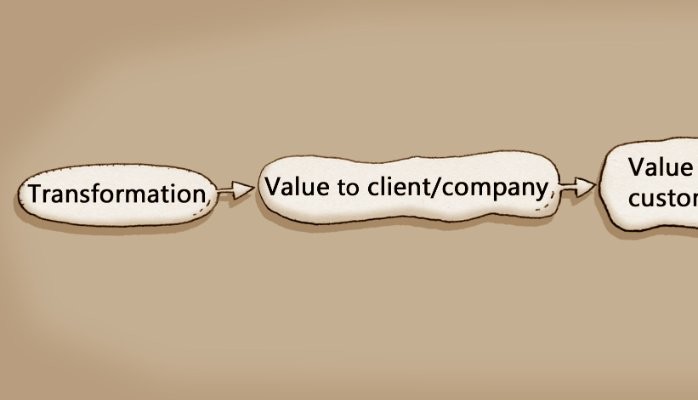
Value: the ultimate destination
When setting out on a journey, it is crucial to have a firm idea of where you’re going.
Likewise, when beginning the journey of Organisational Transformation, you must have a firm understanding of what you want to end up with. What type of value are you hoping to create? And who for? Failure to consider these issues has resulted in many people becoming lost on the path of organisational transformation.
Types of value
All products and services have a variety of implicit or explicit features, allowing them to fulfil different emotional needs in a consumer. Let’s look at four: basic, satisfying, attractive or indifferent.
- Basic features: These are the elements of the service that are taken for granted. There is a sizeable negative impact if these features are missing or if performance is poor. For example, when someone is choosing an airline for a flight, they would be deterred from selecting a carrier with a poor safety record. That said, a good safety record isn’t enough to set an airline apart. To really delight a customer, we must go beyond the basics.
- Satisfying features: Responses to these features change in line with availability and performance: the more experience customers have of these features, the more satisfied they are. Satisfying elements are often seen as the key part in a sales pitch.
- Delight features: The service user perceives these features as being unusually high in value. These features can create an unexpected “wow” factor, anticipating needs that customers aren’t even aware of.
- Indifferent features: These are elements that the service user does not value. Indifferent features are often elements introduced in the past, usually as a result of customer requests or as a way for companies to appear unique. After enough time has passed, however, they are not appreciated—and maybe not even noticed—by the customer anymore.
The categories that features fall into will vary between customers as well as through time: since 2000, web browsing on mobile phones has gone from being an attractive feature to a satisfying feature, and is now in the midst of becoming a basic expectation. When examining your value proposition, the question to ask is this: “Is this feature of our value proposition basic, satisfying, attractive or indifferent?” Basic features must be retained, or added if not already present, and indifferent features should not be pursued. Meanwhile, a focus on satisfying and attractive features must be carefully tailored to the customer segment, especially as these typically involve trade-offs with price.
Value for who?
Although the different aspects of value are often implemented with a sole focus on customers, this is only part of the picture. Other stakeholders that must be considered are the organisation and its employees. Sometimes these considerations will result in conflict. Let’s take a look at rail travel, for example:
The customer expects no delays whatsoever. This is impossible for a railway company to deliver without keeping potentially dangerous problems to a minimum. Meanwhile, the employees would like to see greater appreciation from customers when the trains do run on time and no aggressive behaviour when they do not. How do we resolve these tensions?
Having examined this situation in terms of value, an answer is clear: expectation must be managed by continuously informing customers of the reason for delays, the possible length of delays and any alternative travel options. Employees need to be trained to manage these situations. There also needs to be clear communication to customers that incidents of aggression will not be tolerated.
Know your destination before you depart
As we have seen, value analysis delivers a strong first step towards any change effort, providing criteria to help us evaluate what we are currently doing and where we might like to end up. Even more than this, value analysis can suggest harmonious solutions to issues caused by friction between the priorities of organisations, customers and employees.
On the journey of organisational transformation, understanding value is key to arriving at the desired destination without encountering pitfalls along the way.
Ketan Varia
with editorial support from Kira McPherson
This is a modified excerpt from Ketan Varia’s book The Art of Transformational Change, available from Amazon http://ow.ly/Ug6Xt
Find more on our website: https://www.kinetik.uk.com


Founder, The Intelligent Leadership Hub
8yLet a focused understanding of the value you intend to deliver be your North Star.